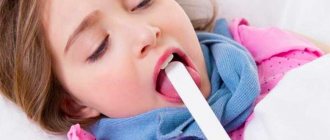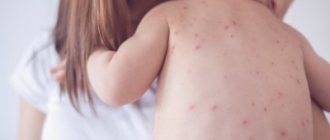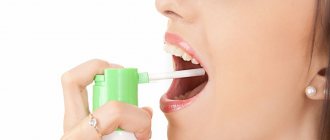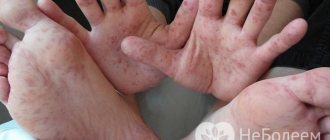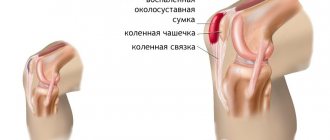Description of the disease
Sore throat (acute tonsillitis) is a common disease of the upper respiratory tract, characterized by the presence of an inflammatory process in the tonsils (tonsils).
The main reason for the occurrence of pathology is the penetration of pathogenic microorganisms into the child’s body. When microorganisms enter the oral cavity, they first encounter the palatine tonsils, a part of the human lymphatic system responsible for the safety of the body. The tonsils begin to fight pathogenic microflora, producing special antibodies that remove “pests” from the body. The danger is this: sometimes the immune system cannot cope with the infection, the tonsils become inflamed and themselves become a source of infection.
If the disease is not treated in a timely manner, all systems of the child's body are at serious risk - complications such as rheumatic disease, infectious arthritis, nephritis, meningitis and other health-threatening pathologies may arise.
Let's try to understand the important question of how to cure a child's sore throat, preventing the development of complications and relapses.
Pathology of fibrinous type
When fibrinous tonsillitis, also called pseudomembranous or pseudodiphtheria, occurs, the child will experience severe fever and chills. Body temperature may rise to critical levels. Symptoms of general intoxication come to the fore: headache and weakness. The causative agents of the pathology are bacteria (streptococcus or staphylococcus), less often adenoviruses.
When examining the baby's throat, a white coating is observed that completely covers the back of the pharynx and tonsils. This is fibrin - a special substance present in large quantities in the blood plasma. It comes out of the burst follicles and, in the form of a homogeneous film, concentrates on the dying tissues of the lacunae, extending beyond the palatine arches.
With the development of fibrinous tonsillitis, the main task of the doctor is to differentiate tonsillitis from diphtheria, which manifests itself in a similar way and can be fatal.
Complications of the disease can include: meningitis, toxic shock, impaired renal function, necrosis of throat tissue.
Symptoms of a sore throat
In children, the symptoms of sore throat are much more pronounced than in adults. The baby becomes restless, cries, and refuses to eat. Often the disease becomes chronic and subsequently recurs. General signs of sore throat in a child:
- increase in body temperature above 39.0C
- intense sore throat;
- pain when swallowing;
- general weakness;
- poor appetite;
- moodiness and tearfulness (in young children).
If left untreated, symptoms of cardiovascular disease may occur: tachycardia, hypotension, chest pain.
The clinical picture of the disease depends on the form of acute tonsillitis. In medicine, it is customary to distinguish catarrhal, follicular, lacunar, fungal, herpetic and ulcerative-necrotic tonsillitis.
Manifestations of catarrhal tonsillitis
The mildest and most common form of the disease is catarrhal. Catarrhal tonsillitis is characterized by superficial damage to the tonsils: their swelling and redness. This form rarely exists as an independent disease, being one of the manifestations of other pathologies of the upper respiratory tract. General symptoms are not very acute - there is an increase in temperature to subfebrile levels (37.1-38C), sore throat and moderate pain in the throat, painful swallowing.
Manifestations of follicular tonsillitis
Follicular (purulent) tonsillitis manifests itself with high body temperature (over 38C), severe sore throat, inability to swallow normally, and increased salivation. Small whitish or yellowish pustules, 1-2 mm in diameter, form on the tonsils. There is an increase in lymph nodes in the neck and back of the head; when palpating the lymph nodes, the child feels pain.
Manifestations of lacunar tonsillitis
The symptoms of lacunar tonsillitis are similar to those of the follicular form. However, in this case the clinical picture is more pronounced. Purulent discharge does not occur on the follicles of the palatine tonsils, but on their ducts (lacunae).
Manifestations of fungal sore throat
With the fungal form of the disease, the child experiences enlargement and slight redness of the tonsils and low-grade body temperature. The main symptom that distinguishes this form is the presence of a bright white cheesy coating on the tonsils, which can be easily removed from the palatal tissues.
Manifestations of herpetic sore throat
The main difference between the herpetic form of the disease is the formation of rashes in the form of many small blisters on the tonsils. Inside each bubble is a colorless liquid. In some cases, small ulcers occur with herpetic sore throat.
Manifestations of ulcerative necrotic tonsillitis
This form of acute tonsillitis is one of the most severe. In a child, areas of necrotic (dead) tissue appear on the palatine tonsils. After the dead tissue is separated, deep ulcers form on the tonsils.
Medicines for lacunar angina for children
Let's consider the most popular medications prescribed to children of different ages for the treatment of lacunar tonsillitis.
Table: description of drugs
| Drug name | At what age is admission allowed? | Contraindications | Advantages and disadvantages |
| Amoxicillin (penicillin antibiotic). Trade names: Amoxil, Amokson, Amosin, Flemoxil Solutab, Ecobol, Apo-Amoxi. | Amoxin, Amokson, Apo-Amoxi - from the first days of life. Flemoxil Solutab - from 1 year. Amoxil - from two years. Ecoball - from three years old. | Gastrointestinal diseases, mononucleosis, renal failure, hypersensitivity. | Advantages:
Flaws:
|
| Azithromycin (a macrolide antibiotic). Trade names: Sumamed, Hemomycin, Azitro-Sandoz. | Sumamed - from 6 months (provided that the child’s weight is more than 10 kilograms). Chemomycin - from 6 months. Azitro-Sandoz - at any age, if the child’s body weight is more than 5 kilograms. | Hypersensitivity to macrolides, severe liver and kidney dysfunction. | Advantages:
Flaws:
|
| Cefadroxil (a cephalosporin antibiotic) | Application is possible at any age. | Hypersensitivity to cephalosporins. | The main advantage of the drug is that side effects are less common than with macrolides. |
| Paracetamol Trade names: Panadol, Calpol, Tsefekon D, etc. | Can be used from 1 month, but up to 3 months should be used with caution. | Neonatal period, hypersensitivity. Use with caution when:
| Advantages:
Flaws:
|
| Ibuprofen Trade names: Ibufen, Nurofen and others. | Some drugs can be used from three months, others - from three years. |
| Advantages:
Flaws:
|
| Zyrtec drops (prescribed to relieve swelling of the tonsils) | From 1 year. | Hypersensitivity to the components of the drug or hydroxyzine. | Advantages:
Flaws:
|
| Tantum Verde (lozenges, spray, rinse solution). | Spray - from three years. Tablets - from five. Rinse solution - from 12 years of age. | Hypersensitivity, phenylketonuria (for use of tablets). | Advantages:
Flaws:
|
| Linex (restores intestinal microflora after exposure to antibiotics) | Can be used from the first days of life. | Hypersensitivity, intolerance to dairy products. | Advantages:
Flaws:
|
| Viferon | Can be used from birth. | Hypersensitivity. | Advantages:
Flaws:
|
As you can see, the main type of therapy for lacunar angina is treatment with antibiotics. You can learn about what influences the choice of a specific drug in this group from the following video (E.O. Komarovsky answers the questions).
Video: how a doctor chooses an antibiotic
Causes of sore throat
Acute tonsillitis occurs due to invasion of the palatine tonsils by pathogenic microorganisms (viruses, bacteria, fungi, or a combination thereof).
Moreover, the infection in young children is more often of viral origin and develops as a result of herpes viruses, adenoviruses, cytomegaloviruses, Epstein-Barr viruses, etc. entering the child’s body. Children over 5 years of age are more susceptible to sore throats of a bacterial nature. The most common bacteria that cause the disease are streptococcus and staphylococcus, or a combination of both. In addition, acute tonsillitis can occur under the influence of pneumococci, spirochetes, and fungi.
The method of transmission of infection is airborne droplets or household contact. A child becomes infected from sick people around him or through contact with toys, dishes and other common items. Normally, a child’s body is able to independently cope with pathogenic microflora; infection occurs only in the presence of factors that reduce the body’s immune forces.
Factors that contribute to the weakening of a child’s immunity:
- hypothermia of the body;
- excessive mental and physical stress;
- unbalanced diet;
- deficiency of microelements necessary for growth and development;
- frequent colds;
- stress.
Phlegmonous sore throat as a consequence of other types of pathology
Phlegmonous tonsillitis (paratonsillitis) does not occur independently. In medical practice, this is a complication caused by sore throat. It is an intratonsillar abscess that develops in the tissues of the tonsils.
Main symptoms of the pathology:
- nasal voice;
- restriction of mouth opening;
- tilting the head towards the formation of the abscess.
Most often, follicular or lacunar tonsillitis leads to the development of paratonsillitis, less often - damage to the tissue of the throat area due to scarlet fever or diphtheria.
Pathology is divided into 3 types and can be edematous, infiltrative and abscessive. Most often, paratonsillitis occurs in adolescents over 15 years of age, rarely in children under 6 years of age. It is characterized by the occurrence of acute pain from the development of an abscess, as a result of which the child cannot even take liquid food. The inflammatory process blocks the jaw joint, so the patient’s mouth can open only a few millimeters.
Approximately on the 12th day from the onset of a sore throat (2-3 days after the acute symptoms subside), the child’s body temperature rises to 40°C, severe weakness, severe headache are noted, and the lymph nodes are enlarged. When examining the oral cavity, a small protrusion is detected in the palate, which gradually transforms into a painful infiltrate, shifting towards the oropharynx.
When ripe, the abscess opens on its own, releasing about 30 ml of foul-smelling green exudate. After this, the child recovers. With surgical intervention, relapse may occur.
Diagnosis of sore throat
If you suspect a child has a sore throat, parents should immediately seek advice from a qualified specialist.
An experienced doctor will help determine the type and stage of the disease and, accordingly, select the optimal treatment. At the initial appointment, the doctor listens to the complaints of the little patient and his parents, examines the child’s oral cavity using a laryngeal speculum or pharyngoscopy (visual examination of the pharynx using artificial light), palpates the lymph nodes, and also asks about contacts with patients. Based on the medical history, the doctor makes a preliminary diagnosis, after which he refers the patient for additional studies to confirm the initial assumption. The following methods are used in diagnosing angina:
- Bacteriological examination of a throat smear to determine the type of pathogen and determine sensitivity to antibiotics.
- Clinical blood test.
- Blood test for C-reactive protein, ASL-O, rheumatoid factor.
The method of treating acute tonsillitis will depend on the results of laboratory and instrumental studies.
Types and forms of pathology
There are several types of sore throats. In medicine, their classification is carried out on the basis of indicators of the etiology and clinical picture of the disease. The second appears when the child is examined by a doctor, who, based on what he sees, analyzes the condition of the tissues and mucous membrane of the pharynx and draws a conclusion about the type of pathology.
Depending on the etiology, angina can be:
- catarrhal;
- follicular;
- lacunar;
- fibrinous;
- herpetic;
- phlegmonous;
- ulcerative-necrotic.
According to the duration of the disease, they are divided into acute and chronic.
Treatment of sore throat
Parents need to understand that seeing a doctor is an integral part of successful therapy. Self-medication can cause irreparable harm to children's health.
General recommendations
Sore throat is a highly contagious disease that requires temporary isolation from the sick child.
Young children are especially susceptible to infection. Transmission of infection through close contact is possible from the first day of illness. Acute tonsillitis is almost always accompanied by high fever; parents need to ensure that the child remains in bed. To speed up the removal of infection from the body and prevent dehydration, the baby must be given large amounts of clean water, compotes, fruit drinks and other liquids.
In addition, parents should know the recommendations for baby nutrition: if you have a sore throat, you should exclude hot, rough, spicy, fried and highly salty foods (to prevent pharyngeal irritation). The children's diet should contain boiled, baked or steamed dishes, pureed non-acidic fruits and vegetables, and low-fat broths.
Elimination of the pathogen
The treatment tactics for the inflammation itself depend on the type of infection that caused damage to the tonsils.
So, with a bacterial form of sore throat, the child is prescribed antibiotics (selected taking into account the sensitivity of a particular pathogen). For viral tonsillitis, the doctor selects antiviral drugs, for fungal tonsillitis - antifungal agents. Often, antibacterial and antiviral agents negatively affect the functioning of the baby’s gastrointestinal tract. To prevent diarrhea, bloating and other unpleasant symptoms, your doctor may prescribe a course of prebiotics and probiotics.
Relieving symptoms of sore throat
In addition to eliminating the causative agent of the disease, it is necessary to direct efforts to relieve the unpleasant symptoms of the disease and improve the overall well-being of the baby.
If the body temperature is high, the child is given antipyretics. At the pharmacy you can buy products that reduce body temperature in various forms of use. For infants, it is recommended to give preference to rectal suppositories; at older ages, oral medications are usually prescribed. Topical sprays, syrups, or lozenges may be used to relieve inflammation and sore throat. Such drugs act directly on the microorganisms that cause the disease.
Often a sore throat is accompanied by severe swelling of the tissues of the pharynx, which causes breathing problems in the baby. In such cases, the doctor may prescribe antihistamines. The remedies not only help to cope with swelling in the throat, but also enhance the effectiveness of antipyretic and painkillers.
The choice of agents and their dosage is determined taking into account the age characteristics of the patient and the severity of the manifestations of the disease.
Rinse
Rinsing with antiseptic and anesthetic solutions helps relieve inflammation and eliminate pain. However, this method of treatment is suitable only for those children who know how to gargle without the help of adults without swallowing the solution. For young children, it is recommended to replace rinsing with mouth irrigation. This treatment method allows you to moisturize the oral cavity, wash away purulent and mucous formations from the surface of the tonsils along with pathogenic microorganisms.
Physiotherapy
In addition to medicinal methods of treating sore throat in children, physiotherapeutic methods have proven themselves to be effective:
- inhalation;
- UHF;
- electrophoresis;
- phonophoresis;
- magnetic therapy;
- laser therapy;
- phototherapy.
Ways to prevent illness
Prevention of sore throat in children allows you to reduce the risk of morbidity in the autumn and winter, when communicating with peers in preschool and school.
What does that require?
- Create a favorable indoor microclimate.
- Regularly carry out wet cleaning and ventilation of rooms.
- Dress your baby according to the weather, avoiding perspiration and hypothermia.
- Maintain a daily routine. For children under 6 years of age, naps during the day are important.
- Carry out hardening procedures.
- Diversify your baby's diet.
- Include exercise in your daily routine. Swimming, for example, is indicated for children from infancy.
- During periods of vitamin deficiency, you can give their synthetic analogues: Alphabet, Multitabs, Centrum. Prevention also includes taking immunomodulators (Viferon, Interferon).
Diet is important. Regular consumption of onions, milk, honey, fermented milk products, whole grain cereals, and beef will help strengthen the body and quickly cope with the infection.
Prevention of sore throat
In order to reduce the likelihood of tonsillitis (acute tonsillitis) to a minimum, parents need to take a competent approach to strengthening the child’s immune system. To do this, the following preventive measures should be observed:
- Lead an active lifestyle - take frequent walks in the fresh air, involve your child in sports activities (running, swimming, football, cycling, etc.).
- Provide the child with a balanced diet - introduce a large amount of fresh vegetables and fruits, herbs, low-fat protein foods into the children's diet, and also limit the consumption of fatty, fried foods, fast food, and fast carbohydrates.
- Monitor the child’s personal hygiene, develop in young children the habit of brushing their teeth and washing their face daily (dental caries can cause infection in the tonsils).
- Ensure comfortable conditions in the children's room - maintain optimal humidity and air temperature (no more than 23C at a humidity of 50-60%), carry out daily wet cleaning and ventilation of the rooms.
- If any symptoms of diseases of the ENT organs occur, bring your child for medical examinations in a timely manner, trust only qualified specialists!
We employ experienced doctors of various specialties who will establish an objective diagnosis and select the correct treatment so that the baby can return to his normal lifestyle as soon as possible!
Features of therapy
Many parents are interested in how and what to treat viral tonsillitis in children in order to quickly eliminate existing symptoms and normalize the child’s well-being. It is imperative to follow certain doctor’s recommendations, in particular:
- ventilate the room frequently;
- carry out regular wet cleaning;
- provide peace to the child;
- drink plenty of warm water;
- eat semi-liquid food that does not irritate the throat.
With viral tonsillitis, antibacterial drugs will not help a child, and they will also lead to a weakened immune system, which will further aggravate his condition. The course of therapy involves the use of drugs that suppress the spread of viral infection. In addition, good results can be obtained by using traditional medicine.
What does a throat look like with a sore throat and coronavirus?
Coronavirus infection manifests itself as a red throat, but the tonsils are practically not enlarged, mucus is present in the usual amount or less. Later, the entire nasopharynx becomes pasty, and swelling of the throat causes congestion and difficulty breathing. There is no plaque on the mucous membranes.
If you look at the throat of a patient with tonsillitis, you can clearly see enlarged, loose tonsils, sometimes even lacunae filled with pus. It is enlarged tonsils that make swallowing and breathing difficult.
What are the general symptoms of the disease?
If you are interested in what types of sore throat there are and how they differ, you should know that all varieties of this disease have common symptoms that are easy to recognize. You should worry about your baby's condition if you observe:
- temperature increase;
- pale skin;
- redness of the throat;
- weakness;
- increased salivation.
You cannot treat a sore throat on your own, since there is a high risk of complications or the disease becoming chronic.
How to treat purulent sore throat in a child
The fight against this disease includes a whole range of medications and proper care for the baby. Parents should understand that this pathology cannot be treated without the use of antibiotics. Therefore, it is not surprising that probiotics are prescribed along with them.
What set of measures is necessary for purulent sore throat in a child:
- Taking antibiotics. This drug will be prescribed even to a child under one year old. This is due to the fact that there is nothing more to combat the bacterial process. The child may be prescribed Amoxiclav, Augmentin, Ecoclave. Less commonly prescribed are Ceftriaxone and Azithromycin. As a rule, the course of antibiotic treatment is at least five days. A local antibiotic, for example Bioparox, may also be prescribed.
- Immunomodulators, for example, Imudon or Immunal.
- In case of high temperature, Nurofen or Paracetamol, Mefenamic acid will be prescribed. Infants are prescribed medications in the form of rectal suppositories.
- Antihistamines, for example, Suprastin, Claritin, Fenistil.
- According to indications, glucocorticoids may be prescribed, for example, Hydrocortisone or Dexamethasone.
- If severe intoxication of the body is detected, the child will be hospitalized, he will be given a drip with a glucose solution, as well as saline and rheosorbilact.
- As a local effect use:
- rinse solution, for example, Chlorhexidine, Miramistin or Furacilin;
- antiseptics in the form of sprays, for example Chlorophyllipt, Ingalipt or Orasept;
- resorption plates, for example, Septefril or Trachisan.
A child of 2 years old may still not be able to gargle properly. Because of this, not only the therapeutic effect is not achieved, but also harm is caused due to ingestion of the medicinal solution. Such babies are prescribed lozenges for sucking.
When my son was 8 years old, we encountered purulent tonsillitis, namely lacunar tonsillitis. Even during the day we were on the beach, nothing foreshadowed trouble. And in the evening the child’s temperature rose to 39, and his throat began to hurt. In the morning I discovered a purulent plaque on my tonsils. The temperature remained stable and was practically not brought down by the tablets. An ambulance was called. The diagnosis was made - lacunar tonsillitis. We were immediately hospitalized in the infectious diseases department. We stayed there for at least a week. Nikita was immediately given an eye drop; due to severe intoxication, the acetone in his urine increased, which is why the diet for sore throat became even stricter. They gave me antibiotic injections and it hurt. In addition, a whole range of medications was prescribed, including antihistamines, gargling with Chlorhexidine (alternately with Furacilin), Lugol throat treatment, antiseptic lozenges and Ingalipt. Fortunately, on the third day, my son’s condition improved significantly, and his temperature no longer exceeded 37.2. When Nikita made a full recovery, we were discharged.
Traditional methods of treatment
Such methods are permissible, however, only with the permission of the treating doctor and as an additional treatment to the main set of medications.
- Tea rose decoction. One tablespoon requires a glass of water. Bring to a boil, infuse for an hour. Gargle up to four times a day.
- Boil the beets until completely soft. The finished broth is filtered after cooling. Gargle the throat.
- Iodine (five drops) is added to half a liter of a weak solution of potassium permanganate, everything is thoroughly mixed and used to gargle.
- Gargling with a solution of sea salt (put a teaspoon in a glass of warm water).
The child is one year old and has a purulent sore throat.
In cases where a one-year-old baby is diagnosed with a purulent form of sore throat, mandatory doctor supervision and full compliance with all his recommendations are required. Do not forget that children at this age do not yet have a strong enough immune system.
Treatment for such a disease in a one-year-old baby includes:
- Taking antibiotics, which are prescribed in the form of a syrup or suspension, but most often in the form of injections, especially if the baby is in the hospital.
- If a toddler’s temperature rises and his health sharply worsens, then an antipyretic can be given even at 37.6 degrees. Children at this age are prescribed drugs based on paracetamol or ibuprofen, in the form of rectal suppositories or syrup.
- One-year-old babies will not be able to dissolve tablets; they should not irrigate their throats with a spray. In this case, the only effective and acceptable method is to treat the tonsils with Lugol's solution, which is applied to a bandage wrapped around the mother's finger. It is necessary to carefully wipe the area where pus accumulates.
Proper care
During the period of illness, the child needs care. This will not only ease his condition, but will also speed up his recovery.
- Make sure that the baby is isolated from other family members, especially children. Provide him with his own utensils.
- Strict bed rest is important.
- Maintaining a proper diet.
- Drink plenty of fluids, always warm drinks.
- Vitamin therapy.
- Ventilation of the room and regular wet cleaning.
Diet for purulent sore throat
It is very important to follow the rules of nutrition during illness. So, what is a diet for a child when he is sick:
- During the period of exacerbation of the disease, liquid, crushed dishes are allowed, for example, oatmeal, fruit or vegetable puree, freshly brewed chicken broth.
- Fermented milk products with a low fat content, such as cottage cheese or yogurt.
- Lean meat and boiled fish are allowed.
- Feed your baby boiled or baked vegetables. The child will happily eat a baked apple.
It is important to know which foods are not recommended to be given to a child with purulent sore throat:
- Eating wholemeal bread.
- Unground porridge, especially pearl barley and corn.
- Salad made from fresh vegetables, especially those with coarse fibers, such as carrots, radishes or cabbage.
- Citrus fruits and fruits with a high acid content, such as plums, apples or pears. When consuming such products, the baby feels severe pain due to the action of acids and mechanical irritation of the tonsils.
- Fatty foods or meat, fish, dairy products with a high percentage of fat content.
- Spicy, fried, pickled or salty dishes.
- Sweets in any form.
However, it is worth understanding that such a diet is typical for the period of exacerbation of the disease, that is, in the first days of the disease. After a few days, when the child’s well-being begins to clearly improve, it will be possible to return to the usual type of nutrition.
You must understand that if you are sick, it makes no sense to force your child to eat. The baby's body knows what it needs. And, if you try to force feed, then disturbances in the functioning of the digestive system may develop. And, consequently, the addition of new symptoms, for example, vomiting or diarrhea.
General recommendations
They must be strictly observed so that the effectiveness of therapy is high, and in order to prevent infection of the disease to other children and adults (it is contagious).
- The child should be isolated, protecting him from visiting kindergarten or school, classes, walks, including spending time on playgrounds;
- The patient must remain in bed. In addition to the fact that he does not feel well during the period of illness, the temperature of a child with a sore throat is usually high, and rest, which the body needs to restore strength to fight the disease, will help to quickly eliminate this symptom;
- To quickly eliminate the causative agent of the disease, you should give the young patient plenty of fluids to drink. This could be warm tea, clean water, natural fruit drinks, compotes, etc.;
- It is necessary to organize proper nutrition for the baby, which will be discussed below.
